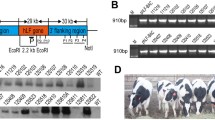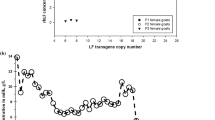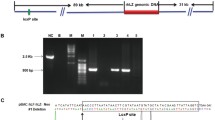Abstract
Genetic engineering, which was first developed in the 1980s, allows for specific additions to animals’ genomes that are not possible through conventional breeding. Using genetic engineering to improve agricultural animals was first suggested when the technology was in the early stages of development by Palmiter et al. (Nature 300:611–615, 1982). One of the first agricultural applications identified was generating transgenic dairy animals that could produce altered or novel proteins in their milk. Human milk contains high levels of antimicrobial proteins that are found in low concentrations in the milk of ruminants, including the antimicrobial proteins lactoferrin and lysozyme. Lactoferrin and lysozyme are both part of the innate immune system and are secreted in tears, mucus, and throughout the gastrointestinal (GI) tract. Due to their antimicrobial properties and abundance in human milk, multiple lines of transgenic dairy animals that produce either human lactoferrin or human lysozyme have been developed. The focus of this review is to catalogue the different lines of genetically engineered dairy animals that produce either recombinant lactoferrin or lysozyme that have been generated over the years as well as compare the wealth of research that has been done on the in vitro and in vivo effects of the milk they produce. While recent advances including the development of CRISPRs and TALENs have removed many of the technical barriers to predictable and efficient genetic engineering in agricultural species, there are still many political and regulatory hurdles before genetic engineering can be used in agriculture. It is important to consider the substantial amount of work that has been done thus far on well established lines of genetically engineered animals evaluating both the animals themselves and the products they yield to identify the most effective path forward for future research and acceptance of this technology.
Similar content being viewed by others
References
Actor JK, Hwang SA, Kruzel ML (2009) Lactoferrin as a natural immune modulator. Curr Pharm Des 15:1956–1973
An LY, Yuan YG, Yu BL, Yang TJ, Cheng Y (2012) Generation of human lactoferrin transgenic cloned goats using donor cells with dual markers and a modified selection procedure. Theriogenology 78:1303–1311
Baker EN, Baker HM (2009) A structural framework for understanding the multifunctional character of lactoferrin. Biochimie 91:3–10
Brundige DR, Maga EA, Klasing KC, Murray JD (2008) Lysozyme transgenic goats’ milk influences gastrointestinal morphology in young pigs. J Nutr 138:921–926
Brundige DR, Maga EA, Klasing KC, Murray JD (2010) Consumption of pasteurized human lysozyme transgenic goats’ milk alters serum metabolite profile in young pigs. Transgenic Res 19:563–574
Campanella L, Martini E, Pintore M, Tomassetti M (2009) Determination of lactoferrin and immunoglobulin g in animal milks by new immunosensors. Sensors (Basel) 9:2202–2221
Carvalho EB, Maga EA, Quetz JS, Lima IF, Magalhães HY, Rodrigues FA, Silva AV, Prata MM, Cavalcante PA, Havt A, Bertolini M, Bertolini LR, Lima AA (2012) Goat milk with and without increased concentrations of lysozyme improves repair of intestinal cell damage induced by enteroaggregative Escherichia coli. BMC Gastroenterol 12:106
Chandan RC, Parry RM, Shahani KM (1968) Lysozyme, lipase, and ribonuclease in milk of various species. J Dairy Sci 51:606–607
Cheng JB, Wang JQ, Bu DP, Liu GL, Zhang CG, Wei HY, Zhou LY, Wang JZ (2008) Factors affecting the lactoferrin concentration in bovine milk. J Dairy Sci 91:970–976
Clark M, Murray JD, Maga EA (2014) Assessing unintended effects of a mammary-specific transgene at the whole animal level in host and non-target animals. Transgenic Res 23:245–256
Commare CE, Tappenden KA (2007) Development of the infant intestine: implications for nutrition support. Nutr Clin Pract 22:159–173
Cooper CA, Brundige DR, Reh WA, Maga EA, Murray JD (2011) Lysozyme transgenic goats’ milk positively impacts intestinal cytokine expression and morphology. Transgenic Res 20:1235–1243
Cooper CA, Nelson KM, Maga EA, Murray JD (2012) Consumption of transgenic cows’ milk containing human lactoferrin results in beneficial changes in the gastrointestinal tract and systemic health of young pigs. Transgenic Res 22:571–578
Cooper CA, Garas Klobas L, Maga EA, Murray JD (2013) Consuming transgenic goats’ milk containing the antimicrobial protein lysozyme helps resolve diarrhea in young pigs. PLoS ONE 8:e58409
Cooper CA, Maga EA, Murray JD (2014) Consumption of transgenic milk containing the antimicrobials lactoferrin and lysozyme separately and in conjunction by 6 week old pigs improves intestinal and systemic health. J Dairy Res 81:30–37
Davidson LA, Lönnerdal B (1987) Persistence of human milk proteins in the breast-fed infant. Acta Paediatr Scand 76:733–740
Du SJ, Gong ZY, Fletcher GL, Shears MA, King MJ, Idler DR, Hew CL (1992) Growth enhancement in transgenic Atlantic salmon by the use of an “all fish” chimeric growth hormone gene construct. Biotechnology (NY) 10:176–181
Ellison RT 3rd, Giehl TJ (1991) Killing of gram-negative bacteria by lactoferrin and lysozyme. J Clin Invest 88:1080–1091
Eschenburg G, Heine W, Peters E (1990) Fecal sIgS and lysozyme excretion in breast feeding and formula feeding. Kinderaerztl Prax 58:255–260
Ginsburg I (2002) Role of lipoteichoic acid in infection and inflammation. Lancet Infect Dis 2:171–179
Goldman AS, Thorpe LW, Goldblum RM, Hanson LA (1986) Anti-inflammatory properties of human milk. Acta Paediatr Scand 75:689–695
Goldman IL, Georgieva SG, Gurskiy YG, Krasnov AN, Deykin AV, Popov AN, Ermolkevich TG, Budzevich AI, Chernousov AD, Sadchikova ER (2012) Production of human lactoferrin in animal milk. Biochem Cell Biol 90:513–519
Golovan SP, Meidinger RG, Ajakaiye A, Cottrill M, Wiederkehr MZ, Barney DJ, Plante C, Pollard JW, Fan MZ, Hayes MA, Laursen J, Hjorth JP, Hacker RR, Phillips JP, Forsberg CW (2001) Pigs expressing salivary phytase produce low-phosphorus manure. Nat Biotechnol 19:741–745
Gordon LI, Douglas SD, Kay NE, Yamada O, Osserman EF, Jacob HS (1979) Modulation of neutrophil function by lysozyme. Potential negative feedback system of inflammation. J Clin Invest 64:226–232
Han ZS, Li QW, Zhang ZY, Yu YS, Xiao B, Wu SY, Jiang ZL, Zhao HW, Zhao R, Li J (2008) Adenoviral vector mediates high expression levels of human lactoferrin in the milk of rabbits. J Microbiol Biotechnol 18:153–159
Hettinga K, van Valenberg H, de Vries S, Boeren S, van Hooijdonk T, van Arendonk J, Vervoort J (2011) The host defense proteome of human and bovine milk. PLoS ONE 6:e19433
Hu W, Zhao J, Wang J, Yu T, Wang J, Li N (2012) Transgenic milk containing recombinant human lactoferrin modulates the intestinal flora in piglets. Biochem Cell Biol 90:485–496
Ibrahim HR, Iwamori E, Sugimoto Y, Aoki T (1998) Identification of a distinct antibacterial domain within the N-lobe of ovotransferrin. Biochim Biophys Acta 1401:289–303
Ibrahim HR, Imazato K, Ono H (2011) Human lysozyme possesses novel antimicrobial peptides within its N-terminal domain that target bacterial respiration. J Agric Food Chem 59:10336–11045
Irwin DM, Gong Z (2003) Molecular evolution of vertebrate goose-type lysozyme genes. J Mol Evol 56:234–242
Jackson KA, Berg JM, Murray JD, Maga EA (2010) Evaluating the fitness of human lysozyme transgenic dairy goats: growth and reproductive traits. Transgenic Res 19:977–986
Jespers L, Sonveaux E, Fastrez J (1992) Is the bacteriophage lambda lysozyme an evolutionary link or a hybrid between the C and V-type lysozymes? Homology analysis and detection of the catalytic amino acid residues. J Mol Biol 228:529–538
Jia HP, Starner T, Ackermann M, Kirby P, Tack BF, McCray PB Jr (2001) Abundant human beta-defensin-1 expression in milk and mammary gland epithelium. J Pediatr 138:109–112
Jimenez-Flores R, Richardson T (1988) Genetic engineering of the caseins to modify the behavior of milk during processing: a review. J Dairy Sci 71:2640–2654
Kanyshkova TG, Buneva VN, Nevinsky GA (2001) Lactoferrin and its biological functions. Biochemistry 66:1–7
Kawakami H, Lönnerdal B (1991) Isolation and function of a receptor for human lactoferrin in human fetal intestinal brush-border membranes. Am J Physiol 261:G841–G846
Krimpenfort P, Rademakers A, Eyestone W, van der Schans A, van den Broek S, Kooiman P, Kootwijk E, Platenburg G, Pieper F, Strijker R (1991) Generation of transgenic dairy cattle using ‘in vitro’ embryo production. Biotechnology (NY) 9:844–847
Król J, Litwińczuk Z, Brodziak A, Barłowska J (2010) Lactoferrin, lysozyme and immunoglobulin G content in milk of four breeds of cows managed under intensive production system. Pol J Vet Sci 13:357–361
Kurasawa T, Takada K, Ohno N, Yadomae T (1996) Effects of murine lysozyme on lipopolysaccharide-induced biological activities. FEMS Immunol Med Microbiol 13:293–301
Lee M, Kovacs-Nolan J, Yang C, Archibold T, Fan MZ, Mine Y (2009) Hen egg lysozyme attenuates inflammation and modulates local gene expression in a porcine model of dextran sodium sulfate (DSS)-induced colitus. J Agric Food Chem 57:2233–2240
Leitch EC, Willcox MD (1999) Lactoferrin increases the susceptibility of S. epidermidis biofilms to lysozyme and vancomycin. Curr Eye Res 19:12–19
León-Sicairos N, López-Soto F, Reyes-López M, Godínez-Vargas D, Ordaz-Pichardo C, de la Garza M (2006) Amoebicidal activity of milk, apo-lactoferrin, sIgA and lysozyme. Clin Med Res 4:106–113
Liao Y, Lopez V, Shafizadeh TB, Halsted CH, Lönnerdal B (2007) Cloning of a pig homologue of the human lactoferrin receptor: expression and localization during intestinal maturation in piglets. Comp Biochem Physiol A: Mol Integr Physiol 148:584–590
Liao Y, Jiang R, Lönnerdal B (2012) Biochemical and molecular impacts of lactoferrin on small intestinal growth and development during early life. Biochem Cell Biol 90:476–484
Liu J, Luo Y, Liu Q, Zheng L, Yang Z, Wang Y, Su J, Quan F, Zhang Y (2013) Production of cloned embryos from caprine mammary epithelial cells expressing recombinant human β-defensin-3. Theriogenology 79:660–666
Ma QQ, Lv YF, Gu Y, Dong N, Li DS, Shan AS (2013) Rational design of cationic antimicrobial peptides by the tandem of leucine-rich repeat. Amino Acids 44:1215–1224
Maga EA, Murray JD (1995) Mammary gland expression of transgenes and the potential for altering the properties of milk. Nat Biotech 13:1452–1457
Maga EA, Anderson GB, Murray JD (1995) The effect of mammary gland expression of human lysozyme on the properties of milk from transgenic mice. J Dairy Sci 78:2645–2652
Maga EA, Cullor JS, Smith W, Anderson GB, Murray JD (2006a) Human lysozyme expressed in the mammary gland of transgenic dairy goats can inhibit the growth of bacteria that cause mastitis and the cold-spoilage of milk. Foodborne Pathog Dis 3:384–392
Maga EA, Shoemaker CF, Rowe JD, Bondurant RH, Anderson GB, Murray JD (2006b) Production and processing of milk from transgenic goats expressing human lysozyme in the mammary gland. J Dairy Sci 89:518–524
Maga EA, Walker RL, Anderson GB, Murray JD (2006c) Consumption of milk from transgenic goats expressing human lysozyme in the mammary gland results in the modulation of intestinal microflora. Transgenic Res 15:515–519
Maga EA, Desai PT, Weimer BC, Dao N, Kültz D, Murray JD (2012) Consumption of lysozyme-rich milk can alter microbial fecal populations. Appl Environ Microbiol 78:6153–6160
Mao R, Teng D, Wang X, Xi D, Zhang Y, Hu X, Yang Y, Wang J (2013) Design, expression, and characterization of a novel targeted plectasin against methicillin-resistant Staphylococcus aureus. Appl Microbiol Biotechnol 97:3991–4002
Mcinnis EA, Kalanetra KM, Mills DA, Maga EA (2015) Analysis of raw goat milk microbiota: impact of stage of lactation and lysozyme on microbial diversity. Food Microbiol 46:121–131
Montagne P, Cuillière ML, Molé C, Béné MC, Faure G (2001) Changes in lactoferrin and lysozyme levels in human milk during the first twelve weeks of lactation. Adv Exp Med Biol 501:241–247
Mountzouris KC, McCartney AL, Gibson GR (2002) Intestinal microflora of human infants and current trends for its nutritional modulation. Br J Nutr 87:405–420
Murray JD, Maga EA (2010) Is there a risk from not using GE animals? Transgenic Res 19:357–361
Newburg DS, Walker WA (2007) Protection of the neonate by the innate immune system of developing gut and of human milk. Pediatr Res 61:2–8
Nicholas K, Loughnan M, Messer M, Munks S, Griffiths M, Shaw D (1989) Isolation, partial sequence and asynchronous appearance during lactation of lysozyme and alpha-lactalbumin in the milk of a marsupial, the common ringtail possum (Pseudocheirus peregrinus). Comp Biochem Physiol B 94:775–778
Nielsen SM, Hansen GH, Danielsen EM (2010) Lactoferrin targets T cells in the small intestine. J Gastroenterol 45:1121–1128
Ohno N, Morrison DC (1989a) Lipopolysaccharide interaction with lysozyme binding of lipopolysaccharide to lysozyme and inhibition of lysozyme enzymatic activity. J Biol Chem 264:4434–4441
Ohno N, Morrison DC (1989b) Lipopolysaccharide interactions with lysozyme differentially affect lipopolysaccharide immunostimulatory activity. Eur J Biochem 186:629–636
Palmiter RD, Brinster RL, Hammer RE, Trumbauer ME, Rosenfeld MG, Birnberg NC, Evans RM (1982) Dramatic growth of mice that develop from eggs microinjected with metallothionein–growth hormone fusion genes. Nature 300:611–615
Piotte CP, Marshall CJ, Hubbard MJ, Collet C, Grigor MR (1997) Lysozyme and alpha-lactalbumin from the milk of a marsupial, the common brush-tailed possum (Trichosurus vulpecula). Biochim Biophys Acta 1336:235–242
Polcyn P, Jurczak M, Rajnisz A, Solecka J, Urbanczyk-Lipkowska Z (2009) Design of antimicrobially active small amphiphilic peptide dendrimers. Molecules 14:3881–3905
Schanler RJ, Goldblum RM, Garza C, Goldman AS (1986) Enhanced fecal excretion of selected immune factors in very low birth weight infants fed fortified human milk. Pediatr Res 20:711–715
Schenkels LC, Veerman EC, Nieuw Amerongen AV (1995) Biochemical composition of human saliva in relation to other mucosal fluids. Crit Rev Oral Biol Med 6:161–175
Short ML, Nickel J, Schmitz A, Renkawitz R (1996) Lysozyme gene expression and regulation. EXS 75:243–257
Simojoki H, Hyvönen P, Orro T, Pyörälä S (2010) High concentration of human lactoferrin in milk of rhLf-transgenic cows relieves signs of bovine experimental Staphylococcus chromogenes intramammary infection. Vet Immunol Immunopathol 136:265–271
Takada K, Ohno N, Yadomae T (1994a) Binding of lysozyme to lipopolysaccharide suppresses tumor necrosis factor production in vivo. Infect Immun 62:1171–1175
Takada K, Ohno N, Yadomae T (1994b) Detoxification of lipopolysaccharide (LPS) by egg white lysozyme. FEMS Immunol Med Microbiol 9:255–263
Thomassen EA, van Veen HA, van Berkel PH, Nuijens JH, Abrahams JP (2005) The protein structure of recombinant human lactoferrin produced in the milk of transgenic cows closely matches the structure of human milk-derived lactoferrin. Transgenic Res 14:397–405
van Berkel PH, Welling MM, Geerts M, van Veen HA, Ravensbergen B, Salaheddine M, Pauwels EK, Pieper F, Nuijens JH, Nibbering PH (2002) Large scale production of recombinant human lactoferrin in the milk of transgenic cows. Nat Biotechnol 20:484–487
van der Linden DS, Short D, Dittmann A, Yu PL (2009) Synergistic effects of ovine-derived cathelicidins and other antimicrobials against Escherichia coli O157:H7 and Staphylococcus aureus 1056 MRSA. Biotechnol Lett 31:1265–1267
Wakabayashi H, Koji Yamauchi K, Takase M (2006) Lactoferrin research, technology and applications. Int Dairy J 16:1241–1251
Walker A (2010) Breast milk as the gold standard for protective nutrients. J Pediatr 156:S3–S7
Wang X, Liu S, Xu H, Yan W (2012) Effects of recombinant human lactoferrin on improving the iron status of IDA rats. Wei Sheng Yan Jiu 41:13–17
Wheeler MB, Bleck GT, Donovan SM (2001) Transgenic alteration of sow milk to improve piglet growth and health. Reprod Suppl 58:313–324
Wiesner J, Vilcinskas A (2010) Antimicrobial peptides: the ancient arm of the human immune system. Virulence 1:440–464
Xie H, Huff GR, Huff WE, Balog JM, Rath NC (2002) Effects of ovotransferrin on chicken macrophages and heterophil-granulocytes. Dev Comp Immunol 26:805–815
Yang P, Wang J, Gong G, Sun X, Zhang R, Du Z, Liu Y, Li R, Ding F, Tang B, Dai Y, Li N (2008) Cattle mammary bioreactor generated by a novel procedure of transgenic cloning for large-scale production of functional human lactoferrin. PLoS ONE 3:e3453
Yang B, Wang J, Tang B, Liu Y, Guo C, Yang P, Yu T, Li R, Zhao J, Zhang L, Dai Y, Li N (2011) Characterization of bioactive recombinant human lysozyme expressed in milk of cloned transgenic cattle. PLoS ONE 6:e17593
Yeh TC, Wilson AC, Irwin DM (1993) Evolution of rodent lysozymes: isolation and sequence of the rat lysozyme genes. Mol Phylogenet Evol 2:65–75
Yen CC, Lin CY, Chong KY, Tsai TC, Shen CJ, Lin MF, Su CY, Chen HL, Chen CM (2009) Lactoferrin as a natural regimen for selective decontamination of the digestive tract: recombinant porcine lactoferrin expressed in the milk of transgenic mice protects neonates from pathogenic challenge in the gastrointestinal tract. J Infect Dis 199:590–598
Yu T, Guo C, Wang J, Hao P, Sui S, Chen X, Zhang R, Wang P, Yu G, Zhang L, Dai Y, Li N (2011) Comprehensive characterization of the site-specific N-glycosylation of wild-type and recombinant human lactoferrin expressed in the milk of transgenic cloned cattle. Glycobiology 21:206–224
Yu H, Chen J, Sun W, Liu S, Zhang A, Xu X, Wang X, He Z, Liu G, Cheng G (2012) The dominant expression of functional human lactoferrin in transgenic cloned goats using a hybrid lactoferrin expression construct. J Biotechnol 161:198–205
Yu H, Gao J, Lu Y, Guang H, Cai S, Zhang S, Wang Y (2013) Molecular cloning, sequence analysis and phylogeny of first caudata g-type lysozyme in axolotl (Ambystoma mexicanum). Zoolog Sci 30:938–943
Zhang P, Sawicki V, Lewis A, Hanson L, Nuijens JH, Neville MC (2001) Human lactoferrin in the milk of transgenic mice increases intestinal growth in ten-day-old suckling neonates. Adv Exp Med Biol 501:107–113
Zhang R, Guo C, Sui S, Yu T, Wang J, Li N (2012) Comprehensive assessment of milk composition in transgenic cloned cattle. PLoS ONE 7:e49697
Zhou C, Wang JW, Huang KL, He X, Chen XP, Sun H, Yu T, Che HL (2011) A 90-day safety study in Sprague-Dawley rats fed milk powder containing recombinant human lactoferrin (rhLF) derived from transgenic cloned cattle. Drug Chem Toxicol 34:359–368
Author information
Authors and Affiliations
Corresponding author
Rights and permissions
About this article
Cite this article
Cooper, C.A., Maga, E.A. & Murray, J.D. Production of human lactoferrin and lysozyme in the milk of transgenic dairy animals: past, present, and future. Transgenic Res 24, 605–614 (2015). https://doi.org/10.1007/s11248-015-9885-5
Received:
Accepted:
Published:
Issue Date:
DOI: https://doi.org/10.1007/s11248-015-9885-5




